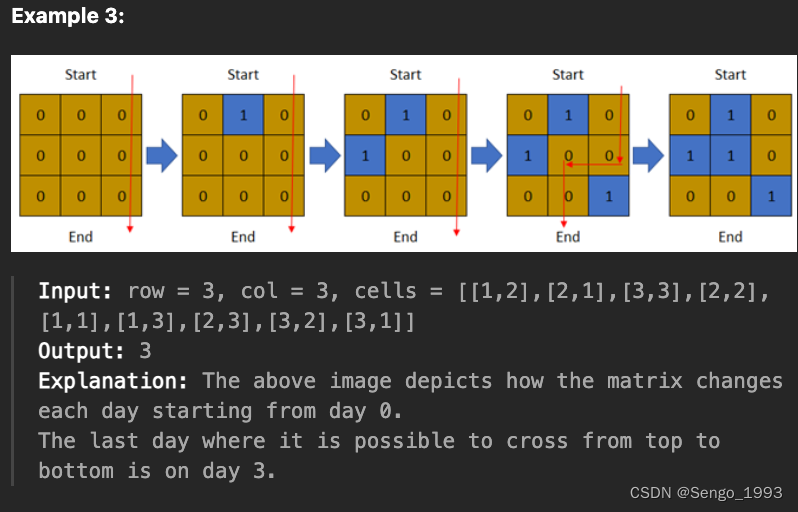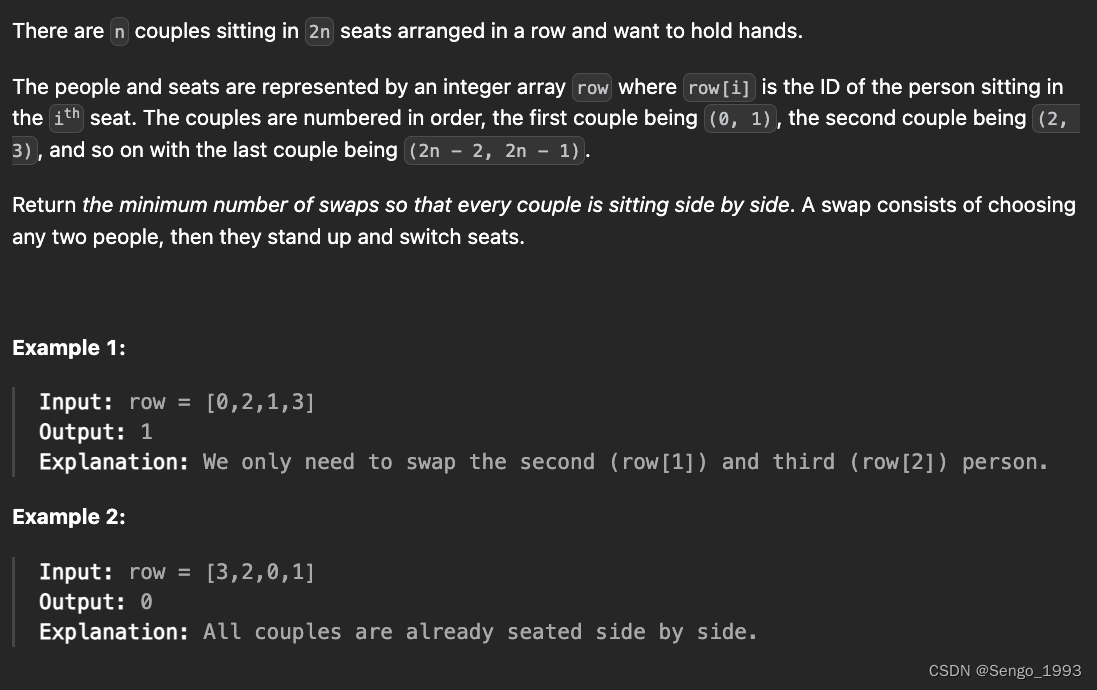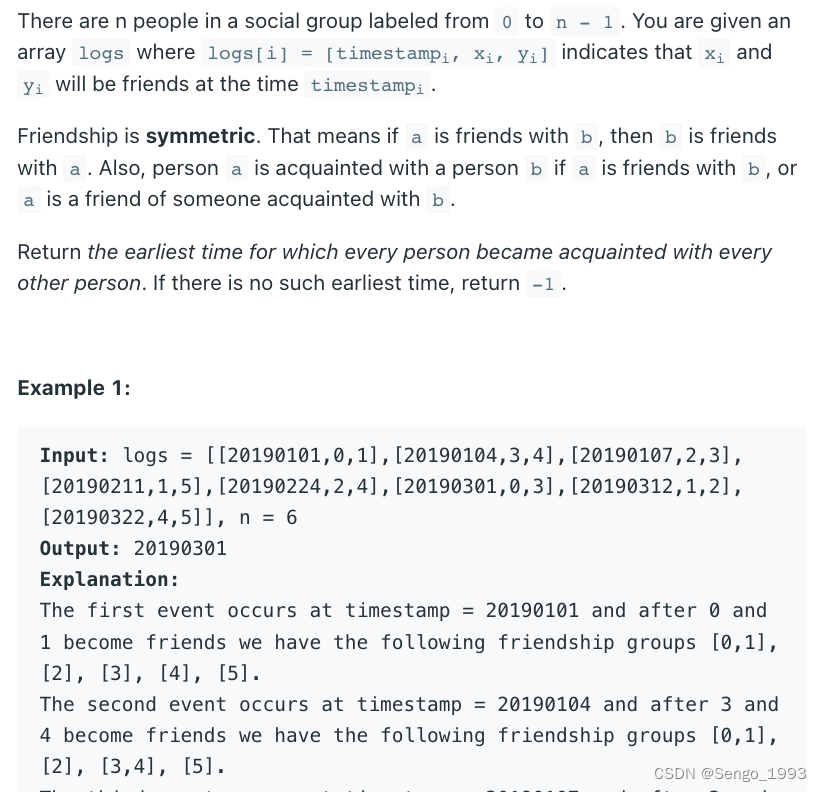parents = range(n)
rank = [0] * n
def find(edge):
if parents[edge] != edge:
parents[edge] = find(parents[edge])
return parents[edge]
#
def find(a):
if parents[a] != a:
return find(parents[a])
return a
def union(x, y):
x, y = find(x), find(y)
if x != y:
if rank[x] >= rank[y]:
parents[y] = x
rank[x] += rank[x] == rank[y]
else:
parents[x] = y
def union(a, b):
pa, pb = find(a), find(b)
parent[pb] = pa
1970. Last Day Where You Can Still Cross
class Solution:
def latestDayToCross(self, n: int, m: int, cells: List[List[int]]) -> int:
maxDay = 0
visited = set() # water has been visited
p = list(range(n*m)) # for union find, we will union water with 8 directions.
crossSet = {} # map from a node to a list of columns, once a parent node has cross all the columns,
# it block from top to butoom access
def find(a):
if p[a] != a:
p[a] = find(p[a])
return p[a]
def union(a, b, ja, jb):
pa = find(a)
pb = find(b)
# print("pb", pb)
c1 = crossSet.get(pa, {ja})
c2 = crossSet.get(pb, {jb})
c3 = c1.union(c2)
crossSet[pa] = c3
p[pb] = pa
if len(c3) == m: # means cross all the columns
return True
for x, y in cells:
x, y = x - 1, y - 1 # change to 0 based
visited.add((x, y))
a = x * m + y # every row has m elements
# print("maxDay", maxDay)
# print(x, y, "a", a)
union(a, a, y, y)
for dx, dy in [(0, 1), (0, -1), (1, 0), (-1, 0), (-1, -1), (-1, 1), (1, -1), (1, 1)]:
nx, ny = x+dx, y+dy
if 0 <= nx < n and 0 <= ny < m and (nx, ny) in visited:
b = nx * m + ny
# print(nx, ny, "b", b)
if union(a, b, y, ny): # union nearby waters in 8 directions
return maxDay
# print(crossSet)
maxDay += 1
return 01102. Path With Maximum Minimum Value
class Solution:
def maximumMinimumPath(self, grid: List[List[int]]) -> int:
# https://leetcode.com/problems/path-with-maximum-minimum-value/solutions/1784266/path-with-maximum-minimum-value/
# approach 1 BFS + heap (max). variant of Dijkstra's
'''
m, n = len(grid), len(grid[0])
re = grid[0][0]
h = [(-grid[0][0], 0, 0)] # value, x, y
visited = set([(0, 0)])
while h:
val, x, y = heapq.heappop(h)
re = min(re, -val)
if x == m-1 and y == n-1:
return re
for dx, dy in [(-1, 0), [1, 0], [0, -1], [0, 1]]:
nx = x + dx
ny = y + dy
if 0 <= nx < m and 0 <= ny < n and (nx, ny) not in visited:
heapq.heappush(h, (-grid[nx][ny], nx, ny))
visited.add((nx, ny))
return re
'''
# approach 2 Union Find
# sort 所有的数字, 从大到小一个个拿, 无所谓他们的位置, 一直拿到一个数字这时候拿了的数字可以把头尾连起来,返回当前这个数字
m, n = len(grid), len(grid[0])
parent = list(range(m*n))
vals = [(r, c) for r in range(m) for c in range(n)]
vals.sort(key = lambda x: grid[x[0]][x[1]], reverse=True) # from large to small
visited = set()
def find(x):
if x != parent[x]:
parent[x] = find(parent[x])
return parent[x]
def union(a, b):
pa, pb = find(a), find(b)
parent[pb] = pa
for x, y in vals:
pos = x * n + y
visited.add(pos)
for dx, dy in [(-1, 0), [1, 0], [0, -1], [0, 1]]:
nx = x + dx
ny = y + dy
npos = nx*n + ny
if 0 <= nx < m and 0 <= ny < n and npos in visited:
union(pos, npos)
if find(0) == find(n*m - 1):
return grid[x][y]=======================================
765. Couples Holding Hands
2 <= n <= 30
class Solution:
def minSwapsCouples(self, row: List[int]) -> int:
'''
row: 2, 3, 1, 0, 5, 4
idx: 0, 1, 2, 3, 4, 5
2 cyclic index groups:
group 1: 0 --> 2 --> 1 --> 3 --> 0 (size: 4)
group 2: 4->5->4 (size: 3)
make group 1 elements 2 3 1 0 to become 0 1 2 3 need min (size-1) swaps
make group 2 elements 5 4 to become 4 5 also need min (size - 1) swaps
first, find the number of groups, assume k cyclic groups
which is C1, C2 ,,, Ck
elements of each group is n1, n2 .. nk, total N
total swaps = (n1 - 1) + (n2 - 1) + ... (nk - 1) = N-k
'''
n = len(row) // 2
def coupleGroup(i): # id = i will be in couple group i // 2
return i // 2
# if A, B are not couple but sit togehter, union these 2 couple groups
# find the # of couple groups k
# total swaps = n - k
parent = [i for i in range(n)] # parent of the group
def find(a):
if parent[a] != a:
return find(parent[a])
return a
def union(a, b):
pa, pb = find(a), find(b)
parent[pb] = pa
for i in range(n):
a = row[i*2]
b = row[i*2+1]
coupleGroupA = coupleGroup(a)
coupleGroupB = coupleGroup(b)
if coupleGroupA != coupleGroupB:
union(coupleGroupA, coupleGroupB)
dist = set()
for i in range(n):
g = find(i)
dist.add(g)
k = len(dist)
return n-k1101. The Earliest Moment When Everyone Become Friends
class Solution:
def earliestAcq(self, logs: List[List[int]], n: int) -> int:
logs = sorted(logs)
parents = [i for i in range(n)]
self.groups = n
def find(n):
if parents[n] != n:
parents[n] = find(parents[n])
return parents[n]
def union(a, b):
x, y = find(a), find(b)
if x != y:
parents[y] = x
self.groups -= 1
for t, a, b in logs:
union(a, b)
if self.groups == 1:
return t
return -1帮忙做的华为笔试的一道题,具体题目不知道,只有一张图片,推测是找环:

随手写了一下代码: 也可以用拓扑排序做,dfs的时候把path加上,如果找到环就把path加到res里面,思路和union-find类似。
class Solution(object):
def find_circle(self):
graph = {1: [2, 3], 4: [1], 3: [4], 2:[4]}
parents = range(5)
self.res = []
def find(node, path):
if parents[node] != node:
return find(parents[node], path + [node])
return node, path + [node]
def union(parent_node, child_node):
p1, path1 = find(parent_node, [])
p2, path2 = find(child_node, [])
if p1 == p2: # find circle
circle = path1 if len(path1) > len(path2) else path2
self.res.append(sorted(circle))
parents[child_node] = parent_node
for parent, childs in graph.items():
for child in childs:
union(parent, child)
return self.res
if __name__ == '__main__':
s = Solution()
print s.find_circle()"""
Google 第一轮:一条直路 分布在坐标y1, y2 之间, 这条路上分布了很多灯(x,y),
灯光照亮范围是半径为r的圆形,照亮的地方无法通过, 问从左往右走,是否能通过这条路
"""
import math
from collections import defaultdict
class Circle:
def __init__(self, x, y, r):
self.x = x
self.y = y
self.r = r
def intersect(self, other: 'Circle'):
if math.pow(self.x - other.x, 2) + math.pow(self.y - other.y, 2) <= math.pow(self.r + other.r, 2):
return True
return False
def __repr__(self):
return f'<{(self.x, self.y)}>'
def __lt__(self, other: 'Circle'):
return (self.x, self.y, self.r, id(self)) < (other.x, other.y, other.r, id(other))
class Solution:
def can_pass(self, y1, y2, circles):
assert y1 <= y2
fathers = self._union_find(circles)
group_dct = defaultdict(set)
for c, root in fathers.items():
group_dct[root].add(c)
print(group_dct)
print(fathers)
for circle_set in group_dct.values():
group_upper_y, group_lower_y = self.get_upper_lower(circle_set)
print(group_upper_y, group_lower_y)
if group_upper_y >= y2 and group_lower_y <= y1:
return False
return True
def get_upper_lower(self, circles):
return (
max(c.y + c.r for c in circles),
min(c.y - c.r for c in circles),
)
def _union_find(self, circles):
fathers = {c: c for c in circles}
for i in range(len(circles)):
c1 = circles[i]
for j in range(i + 1, len(circles)):
c2 = circles[j]
if c1.intersect(c2):
self._merge(fathers, c1, c2)
return fathers
def _merge(self, fathers, c1, c2):
root1 = self._find(fathers, c1)
root2 = self._find(fathers, c2)
if root1 is not root2:
if root1 < root2:
fathers[root2] = root1
self._find(fathers, c2)
else:
fathers[root1] = root2
self._find(fathers, c1)
def _find(self, fathers, c):
root = c
while fathers[root] is not root:
root = fathers[root]
while fathers[c] is not c:
c, fathers[c] = fathers[c], root
return root
import unittest
class Test(unittest.TestCase):
def test1(self):
circles = [
Circle(x, y , r) for x, y, r in [
(1, 1, 1),
(1, 2, 1),
(1, 5, 1),
(1, 6, 1),
(1, 3, 1),
]
]
sol = Solution()
self.assertEqual(
sol.can_pass(1, 2, circles),
False
)
def test2(self):
circles = [
Circle(x, y , r) for x, y, r in [
(0, 1, 1),
(1, 2, 1),
(3, 0, 1),
(3, 1, 1),
]
]
sol = Solution()
self.assertEqual(
sol.can_pass(-1, 3, circles),
True
)
unittest.main(verbosity=2)945. Minimum Increment to Make Array Unique

class Solution:
def minIncrementForUnique(self, nums: List[int]) -> int:
'''
Sort the input array.
Compared with previous number,
the current number need to be at least prev + 1. O(NlogN)
'''
# nums.sort()
# re = 0
# for i in range(1, len(nums)):
# pre = nums[i-1]
# cur = nums[i]
# if cur <= pre:
# re += pre + 1 - cur
# nums[i] = pre + 1
# return re
#################################
# O(n)? union find
root = {}
def find(x):
root[x] = find(root[x] + 1) if x in root else x
return root[x]
re = 0
for n in nums:
# print(n, find(n))
re += find(n) - n
return reTraveling is Fun
def connectedCities(n, g, originCities, destinationCities):
n += 1
parent = list(range(n))
rank = [0] * n
def find(x):
if x != parent[x]:
parent[x] = find(parent[x])
return parent[x]
def union(x, y):
x, y = find(x), find(y)
if x != y:
if rank[x] >= rank[y]:
parent[y] = x
rank[x] += rank[x] == rank[y]
else:
parent[x] = y
for i in range(g + 1, n):
f = 2
while i * f < n:
union(i, i * f)
f += 1
return [int(find(s) == find(d)) for s, d in zip(originCities, destinationCities)]947. Most Stones Removed with Same Row or Column
Loading...
Time Complexity: O(N \log N)O(NlogN), where NN is the length of stones. (If we used union-by-rank, this can be O(N * \alpha(N))O(N∗α(N)), where \alphaα is the Inverse-Ackermann function.)
class DSU:
def __init__(self, N):
self.p = range(N)
def find(self, x):
if self.p[x] != x:
self.p[x] = self.find(self.p[x])
return self.p[x]
def union(self, x, y):
xr = self.find(x)
yr = self.find(y)
self.p[xr] = yr
class Solution(object):
def removeStones(self, stones):
N = len(stones)
dsu = DSU(20000)
for x, y in stones:
dsu.union(x, y + 10000)
return N - len({dsu.find(x) for x, y in stones})305. Number of Islands II

不用Union by rank 也能通过
class Solution(object):
def numIslands2(self, m, n, positions):
"""
:type m: int
:type n: int
:type positions: List[List[int]]
:rtype: List[int]
"""
parent, rank = {}, {}
def find(x):
if parent[x] != x:
parent[x] = find(parent[x]) # path compression
return parent[x]
def union(x, y):
p1, p2 = find(x), find(y)
if p1 == p2:
return 0
else: # union by rank
if rank[p1] < rank[p2]:
parent[p1] = p2
else:
parent[p2] = p1
if rank[p1] == rank[p2]:
rank[p1] += 1
return 1
res, count = [], 0
for i, j in positions:
x = i, j
parent[x] = x
rank[x] = 0
count += 1
for y in (i+1, j), (i-1, j), (i, j+1), (i, j-1):
if y in parent:
count -= union(x, y)
res.append(count)
return res323. Number of Connected Components in an Undirected Graph
class Solution(object):
def countComponents(self, n, edges):
parents = range(n)
def find(a):
if parents[a] != a:
return find(parents[a])
return a
def union(b, p1):
while True:
p = parents[b]
parents[b] = p1
if p != b:
b = p
else:
break
for a, b in edges:
p1, p2 = find(a), find(b)
if p1 != p2:
union(b, p1)
return len({find(x) for x in xrange(n)})
721. Accounts Merge
class Solution(object):
def init(self, accounts):
self.parents = {}
self.owner = {}
for acc in accounts:
owner = acc[0]
root = acc[1] # 第一个邮箱为root, root的特点是指向自己
self.owner[root] = owner
for email in acc[1:]:
if email not in self.parents:
self.parents[email] = root
else:
self.union(root, self.parents[email])
def find(self, x):
if self.parents[x] == x:
return x
self.parents[x] = self.find(self.parents[x])
return self.parents[x]
def union(self, x, y):
px = self.find(x)
py = self.find(y)
self.parents[py] = px
def accountsMerge(self, accounts):
"""
:type accounts: List[List[str]]
:rtype: List[List[str]]
"""
self.init(accounts)
for acc in accounts:
for email in acc[1:]:
self.find(email) # 每次find都会把所有上面的节点指向root
groups = list(set(self.parents.values())) # values的值是父节点
res = []
for j in xrange(len(groups)):
temp = []
for key in self.parents:
if self.parents[key] == groups[j]:
temp.append(key)
temp = sorted(temp)
temp.insert(0, self.owner[groups[j]])
res.append(temp)
return res下面的TLE??
class Solution(object):
def accountsMerge(self, accounts):
parent = {}
owner = {}
def find(email):
if parent[email] != email:
parent[email] = find(parent[email])
return parent[email]
def union(e1, e2):
p1 = parent[e1]
p2 = parent[e2]
parent[p2] = p1
for acc in accounts:
name = acc[0]
root = acc[1]
owner[root] = name
for e in acc[1:]:
if e not in parent:
parent[e] = root
else:
union(root, parent[e])
for e in parent:
find(e)
roots = list(set(parent.values()))
re = []
for root in roots:
temp = []
for e in parent:
if parent[e] == root:
temp.append(e)
temp.sort()
temp.insert(0, owner[root])
re.append(temp)
return re261. Graph Valid Tree

class Solution(object):
def validTree(self, n, edges):
"""
:type n: int
:type edges: List[List[int]]
:rtype: bool
"""
parents = range(n)
def find(b): # 找到root parent
if parents[b] != b:
return find(parents[b])
return b
def union(b, p1): # 把b和b的所有parent 的parent设为p1
while True:
p = parents[b]
parents[b] = p1
if p != b:
b = p
else:
break
for a, b in edges: # 如果edge a, b have the same root parent, then circle, else union
p1 = find(a)
p2 = find(b)
if p1 == p2:
return False # circle
else:
union(b, p1) # union
for i in xrange(n): # check if all the node have the same root parent, if not,there exist more than 1 tree
if i == 0:
p = find(i)
else:
print i, find(i)
if find(i) != p:
return False
return True































 4258
4258











 被折叠的 条评论
为什么被折叠?
被折叠的 条评论
为什么被折叠?








